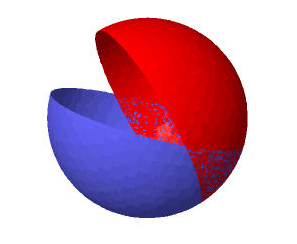I'm curious if anyone can see a route to get the Borsuk-Ulam theorem from Gromov's waist inequality. For the sake of notation, here's the inequality:
Let $S^n$ denote the round unit sphere in $\mathbb{R}^{n+1}$. It carries the spherical measure which we denote $vol(\cdot)$ and a Riemannian metric which induces a distance function $d(\cdot,\cdot)$. We write $S^{n-k}$ for the equatorial $(n-k)$-sphere inside $S^n$: $$ S^{n-k} = \{ (x_1, \dots, x_{n+1}) \in S^n : x_i = 0, i>n-k+1\} $$ For a continuous map $f : S^n \rightarrow \mathbb{R}^k$ we write $S_z = \{s \in S^n : f(s) = z\}$ for the level sets of $f$. Write $U_\epsilon(S) = \{\sigma \in S^n : d(\sigma, S) < \epsilon\}$ for an $\epsilon$-neighbourhood of a subset $S$.
Theorem (Gromov): If $f : S^n \rightarrow \mathbb{R}^k$ is continuous then there is a point $z \in \mathbb{R}^k$ such that: $$ vol(U_\epsilon(S_z)) \geq vol(U_\epsilon(S^{n-k})) $$ for all $\epsilon > 0$.
This inequality is quite strong. It implies the spherical isoperimetric inequality. It also implies topological invariance of domain. For more background, see Guth's survey The Waist Inequality in Gromov's Work.
Getting back to my question: If $n=k$ and the level set given by the inequality contains two points then taking $\epsilon = \pi/2$ gives the Borsuk-Ulam theorem. Can one arrange for this to always happen and hence derive Borsuk-Ulam?

 $U_{\pi/2}$ for two points which are not antipodal.
$U_{\pi/2}$ for two points which are not antipodal.